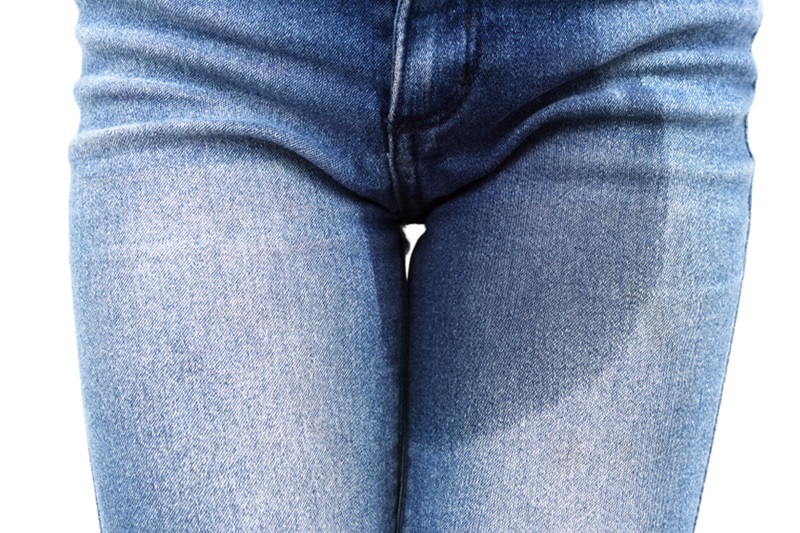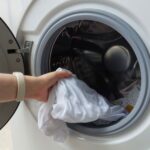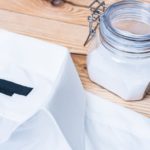Unavoidable accidents happen. You go to change your baby’s nappy, and they decide to have a wee over their cloth diaper and baby grow in the process. It’s a classic move.
If you’re new to the nappy changing scene, you might be wondering if the wee will stain the clothes and diaper or if you’ll be able to get rid of the yellow, odour-filled liquid mess.
Read on to find out if the wee-blemished garments can be saved or if they need to be binned.
Does Pee Stain Clothes?
Urine can stain clothes. However, if you deal with the problem quickly, you can stop the blemish from wreaking too much havoc on your garments.
If you allow the urine to sit on your clothing for too long, the stain will become more difficult to remove, but not necessarily impossible.
In some of the worst cases, where garments have repeatedly been saturated in urine, it might be worth binning these items. In this case, the odour will have sunk deep down and into the fibres and the yellow stain will be even more obvious and unsightly. Plus, bacteria will be thriving in the area.
Why does urine stain clothes?
Urine can stain clothes, and the reason for this is mainly due to the compositions that make up the wee-wees. Take note of the following:
The chemicals in the pee
Urine contains various waste products that have been passed down through the body. This includes urea, creatinine, uric acid and inorganic salts. When these deposits dry, they leave an unsightly stain on materials.
The colour of the urine
Wee is typically yellow in colour. This colour can be attributed to a pigment called urochrome (urobilin). This pigment causes stains and discolouration, especially on lighter items of clothing.
The smell
Urine, especially when it’s left untreated, produces an unpleasant odour which only worsens with time as the stain becomes overridden by bacteria. This, in turn, can damage and blemish the material.
How to Remove Urine Stains from Clothes
Tip: You may have to repeat the cleaning methods below more than once for some urine-stained pieces.
For fresh urine stains
When treating and eradicating urine stains, time is of the essence.
So, the quicker you react and remove the yellow liquid from the item of clothing, the better your chances are of cleaning the garment and taking out the entire stain.
Follow the steps below:
- Grab a cloth or kitchen roll and repeatedly blot at the urine stain. Use a new piece of cloth/paper each time so you don’t reapply the urine. Do not rub or scrub; this drives the pee deeper into the material’s fibres and spreads it.
- Turn the garment inside out.
- Flush cold water through the back of the urine stain.
- Hold the garment under the tap for several minutes.
- Apply an enzyme cleaner to the stain (enzymes can be found in most biological detergents). The enzymes will break down the proteins in the urine. Or use a white vinegar and water mixture (one part vinegar to two parts water).
- Wait about 10 minutes.
- Launder the garment in cold water.
- Optional: add half a cup of white vinegar to the washing machine to help neutralise any wee-wee odour.
For stubborn urine stains
Older urine stains are trickier to remove but not impossible; they just require more elbow grease and time.
It’s likely that you won’t remove all the pee-related stains the first time, and you will have to treat your item of clothing more than once.
If your clothes are colourfast, you can soak them in a bucket of diluted oxygen bleach and water for about two hours and then wash them.
This treatment will remove the stain itself, but it might not eradicate the urine smell; this will be removed after laundering the garment.
You should not try this method out on delicate materials. Bleach will likely damage or discolour the fine fabric. If you’re having trouble removing pee from a delicate piece, ask a dry cleaner for help.
In addition, you could buy an off-the-shelf stain remover or a product like Napisan to treat your urine-stained laundry. But do keep in mind that specialised cleaners often get mixed results, and what will work for one urine stain might not work on another.
If you plan on buying a product, do a patch test with it first to ensure it doesn’t harm the material you want to clean.
Preventing future wee-related mishaps
Here are some ideas you can put into place to manage the situation:
Use waterproof barriers
For those suffering from incontinence, consider wearing protective garments, like pads. These garments are discreet and will stop urine from reaching your outer clothing. Similarly, pop a waterproof liner on the bed to save the mattress from urine.
Establish a toilet routine
Ensure pets and kids are educated effectively about using the toilet and when to go.
For example, take kids to the bathroom every so often so they get used to going and using the facility. You can do the same with puppies to get the toilet trained (just take them outside to pee).
Clean clothes often
Clean clothes often so you don’t get a build-up of urine and foul odours on your clothes.
Keep a kit nearby
Keep a kit containing spare clothes and cleaning supplies near you. You can change your clothes and quickly treat your stained items if an accident should occur.
Take regular toilet breaks
Don’t hold your wee in for longer than necessary. Make a habit of going to the toilet so you don’t put pressure on your bladder and end up with problems in the future.
Consider your clothing choice
Consider wearing clothes that are easy to clean. Cotton clothes, for example, are hard wearing and you can treat stains on them quickly.
You can also machine wash most cotton at a high temperature, which is helpful when you need to clean bacteria-filled garments.
Delicates, on the other hand, like satins and silks, are more complex to clean. You’ve got to be careful when you wash these materials, and you can’t run them through a vigorous, hot washing cycle because they’ll end up ruined.
In turn, cleaning the pee of these materials can be more challenging and time-consuming. Of course, if you want to wear delicate clothes, pair the items with a waterproof barrier (pads) for added protection and peace of mind.
You need to think about how practical it is for you or someone you’re caring for to wear delicate clothing if wee-related mishaps happen often.
You need to make your life as straightforward as possible. One way you can do that is to wear/provide someone with easy-to-keep clean clothes.
The less complicated the laundry process is, the better it is for everyone, especially when caring for a loved one!
FAQs on Urine Stains
Does pee permanently stain clothes?
Urine stains can become permanent if they are left untreated on an item of clothing.
Unfortunately, the longer you leave wee-wees on a piece of clothing, the more time the yellow pigment, chemical compositions and odour have to set in.
The easiest way to manage the stain is to treat it immediately and to launder the garment. See the steps above.
However, if you try the steps above and you can’t remove the stain, consider replacing the garment.
Does dried pee leave a stain?
Yes, dried urine can leave an unsightly stain on a surface. The blemish on your garment will likely be yellow, or the pigment in the wee might’ve discoloured the material.
What happens if you don’t clean urine?
You should act quickly and remove urine from whatever surface it is on. If you leave the pee unattended and don’t bother cleaning it up, you can expect the following:
- A foul smell will start to emanate from the area. This odour will grow stronger with time.
- If a pet did the peeing, they may repeatedly return to the same spot to ‘mark’ it. The urine stains and smells will intensify and be horrible to live with.
- Bacteria will thrive.
- Mould could put in an appearance.
- The surface could end up stained yellow or discoloured.
- The urine might attract pests to the area.
- Surfaces may end up damaged if urine isn’t cleaned off them. Wooded surfaces may rot, for example.
- Allergic reactions could be triggered.
- The air quality in your home will be compromised. Of course, you might not be able to smell the foul odour, but when people visit you, they will.

Bethan has a passion for exploring, reading, cooking and gardening! When she’s not creating culinary delights for her family, she’s concocting potions to keep her house clean!






